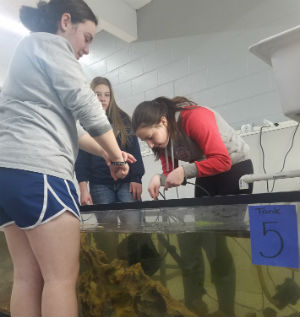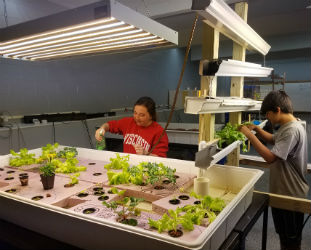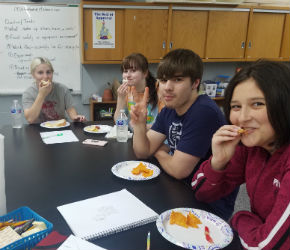Starting an aquaponics class for Clinton Middle School 7th and 8th graders was like wading into “the land of the unknown” for students and teachers alike! But generous donations and previous faculty paved the way for science teachers Dave Fridley and Kendra Statton to tackle an area in which they had little or no training. With a lot of research, planning, and the help of teaching assistant Pam Scribner, they rose to the challenge!

Fridley and Statton stuck to basic science concepts in the elective science course. The general idea behind aquaponics is that fish provide nutrients for hydroponically grown plants that, in turn, purify the water. In Clinton, tilapia feed a 6-foot by 3-foot grow bed of lettuce.

“We do a lot of planning, problem-solving, investigating, collecting, and analyzing data,” says Statton. “A lot of it is student-driven.”
For example, teachers asked the class: Is there a way to have a vertical grow bed that provides the necessary light and fresh water? Working in collaborative groups, some students jumped on YouTube; others sketched out ideas on a whiteboard or Google Sketchup. Fridley and Statton researched an idea of their own in advance, but they were in for a surprise.
“The number of things [students] came up with shocked me,” says Statton. “We didn’t even share our idea!”
Teachers and students then firmed up a plan that made the best use of materials and created the least waste.
There’s much more going on in the class, too. “All of the students have a chance to tap into something that they find personally interesting,” says Fridley. So those interested in animals take an interest in the fish. Others are excited about the mechanics. Still others enjoy helping with manual labor or coming up with new ideas to move the project forward.
In a sense, students are exploring careers: agriculture and aquaculture, but also engineering, construction, and plumbing. “If they can use this as a starting point,” says Statton, “they may be able to see how they could fit it into other things.”
Starting an aquaponics class has been a learning experience for everyone, including the teachers: “Students are capable of doing complex things if they have the interest, desire, and freedom,” says Fridley.
“It’s allowed me the opportunity to get to know my students on a different level,” adds Statton.
The middle school’s relationship with the high school’s CTE program is stronger than ever. This year’s students partnered with the high school in preparing for their annual plant sale, and the agriculture teacher there would like to incorporate aquaponics, which would likely get a boost from current aquaponics students. “Our partnership with the high school ag program will certainly grow,” says Fridley.

Here’s the best part: Aquaponics students and teachers were able to harvest enough tilapia to enjoy a well-deserved end-of-the-year fish fry!
